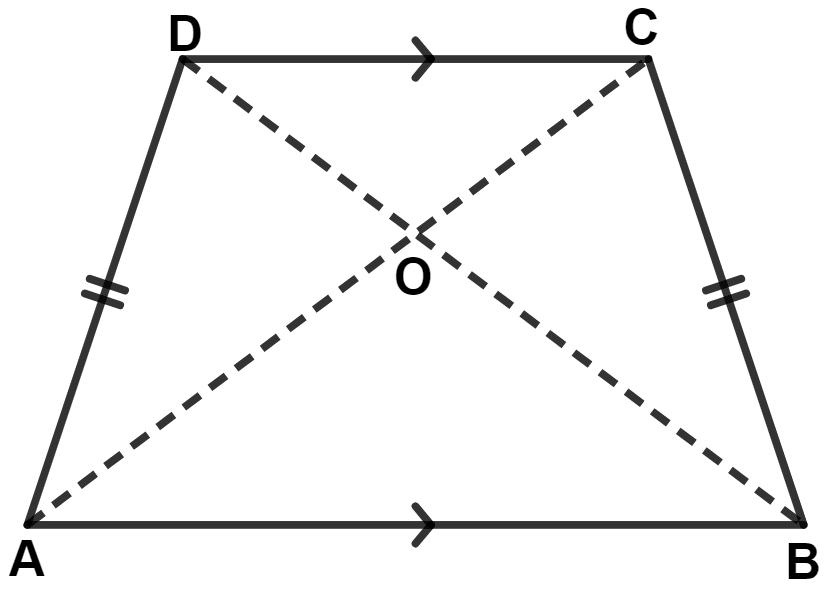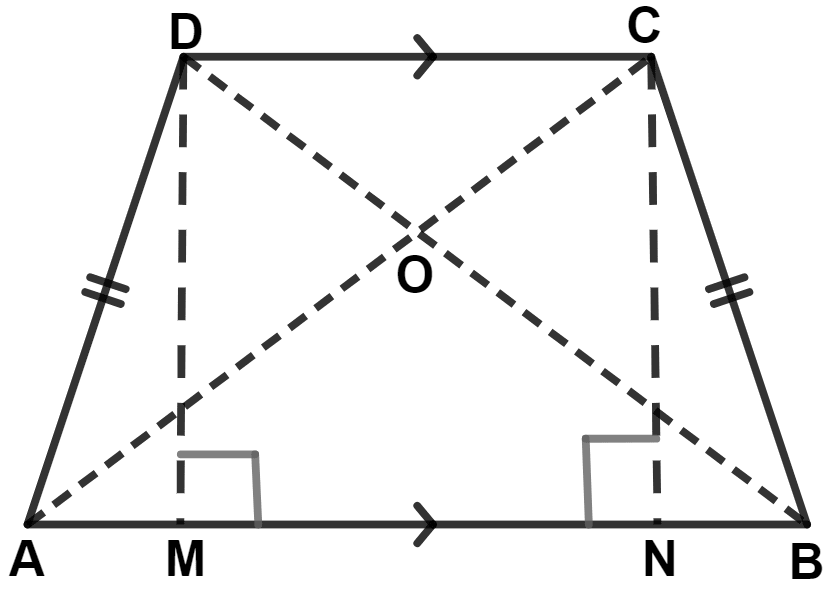Mathematics
The following figure shows a trapezium ABCD in which AB is parallel to DC and AD = BC.
Prove that :
(i) ∠DAB = ∠CBA
(ii) ∠ADC = ∠BCD
(iii) AC = BD
(iv) OA = OB and OC = OD

Rectilinear Figures
8 Likes
Answer
Draw DM ⊥ AB and CN ⊥ AB.

(i) In △ DAM and △ CBN,
⇒ AD = BC (Given)
⇒ ∠DMA = ∠CNB (Both equal to 90°)
⇒ DM = CB (Since, DC || AB, DM ⊥ AB and CN ⊥ AB)
∴ △ DAM ≅ △ CBN (By R.H.S. axiom)
We know that,
Corresponding parts of congruent triangle are equal.
⇒ ∠DAM = ∠CBN ……..(1)
From figure,
⇒ ∠DAM = ∠DAB
⇒ ∠CBN = ∠CBA
Substituting above values in equation (1), we get :
⇒ ∠DAB = ∠CBA.
Hence, proved that ∠DAB = ∠CBA.
(ii) Since, △ DAM ≅ △ CBN
∴ ∠ADM = ∠BCN (By C.P.C.T.C.)
⇒ ∠ADM + 90° = ∠BCN + 90°
⇒ ∠ADC = ∠BCD.
Hence, proved that ∠ADC = ∠BCD.
(iii) In △ ADB and △ BCA,
⇒ AB = AB (Common side)
⇒ ∠DAB = ∠CBA (Proved above)
⇒ AD = BC (Given)
∴ △ ADB ≅ △ BCA (By S.A.S. axiom)
⇒ AC = BD (By C.P.C.T.C.)
Hence, proved that AC = BD.
(iv) In △ OAD and △ OBC,
⇒ ∠OAD = ∠OCB (Alternate angles are equal)
⇒ ∠AOD = ∠BOC (Vertically opposite angles are equal)
⇒ AD = BC (Given)
∴ △ OAD ≅ △ OBC (By A.A.S. axiom)
⇒ OA = OB and OC = OD. (By C.P.C.T.C.)
Hence, proved that OA = OB and OC = OD.
Answered By
5 Likes
Related Questions
ABCD is a square. A is joined to a point P on BC and D is joined to a point Q on AB. If AP = DQ; prove that AP and DQ are perpendicular to each other.
In a quadrilateral ABCD, AB = AD and CB = CD. Prove that :
(i) AC bisects angle BAD.
(ii) AC is perpendicular bisector of BD.
The difference between an exterior angle of (n - 1) sided regular polygon and an exterior angle of (n + 2) sided regular polygon is 6°. Find the value of n.
Two alternate sides of a regular polygon, when produced, meet at right angle. Find :
(i) the value of each exterior angle of the polygon;
(ii) the number of sides in the polygon.